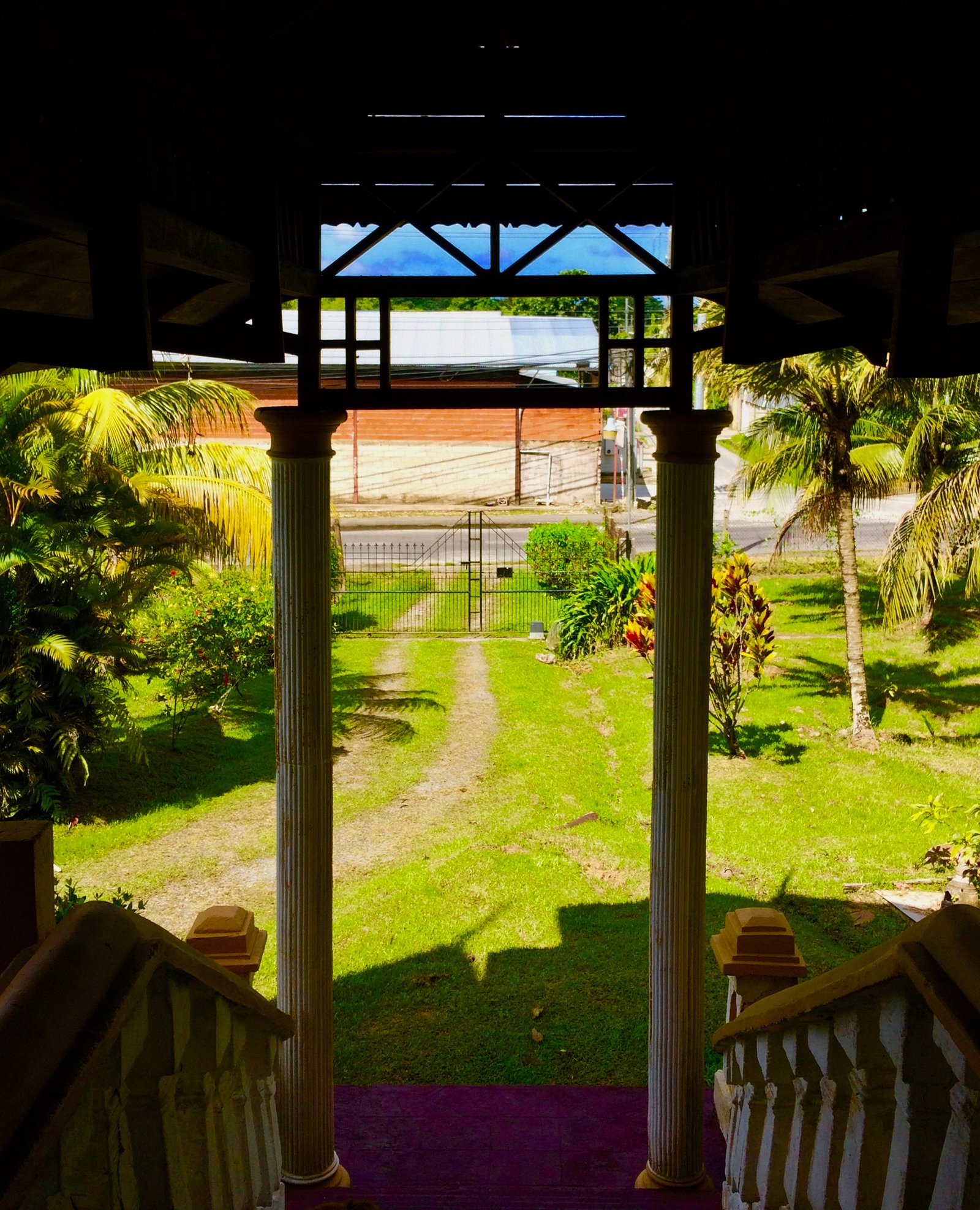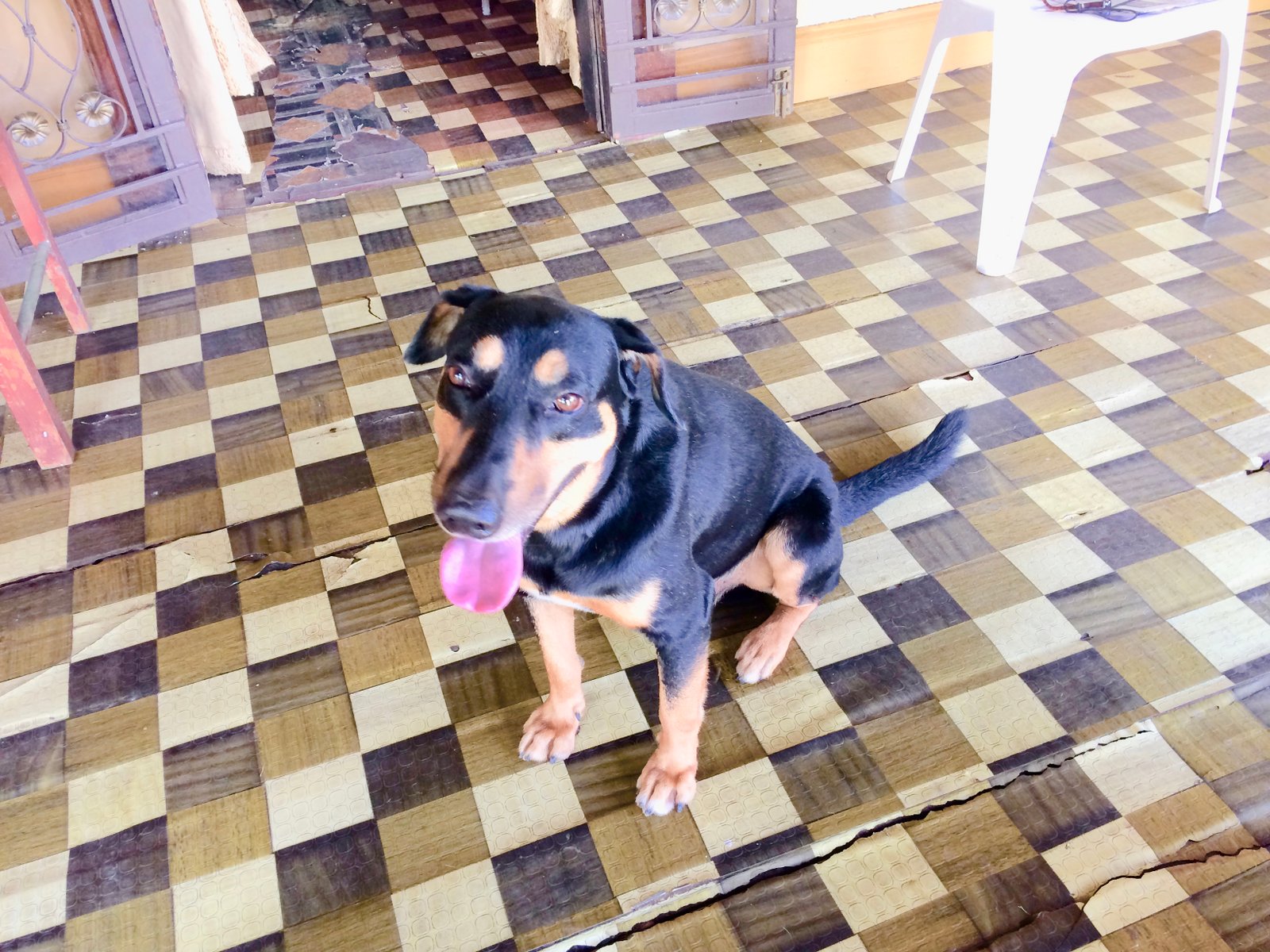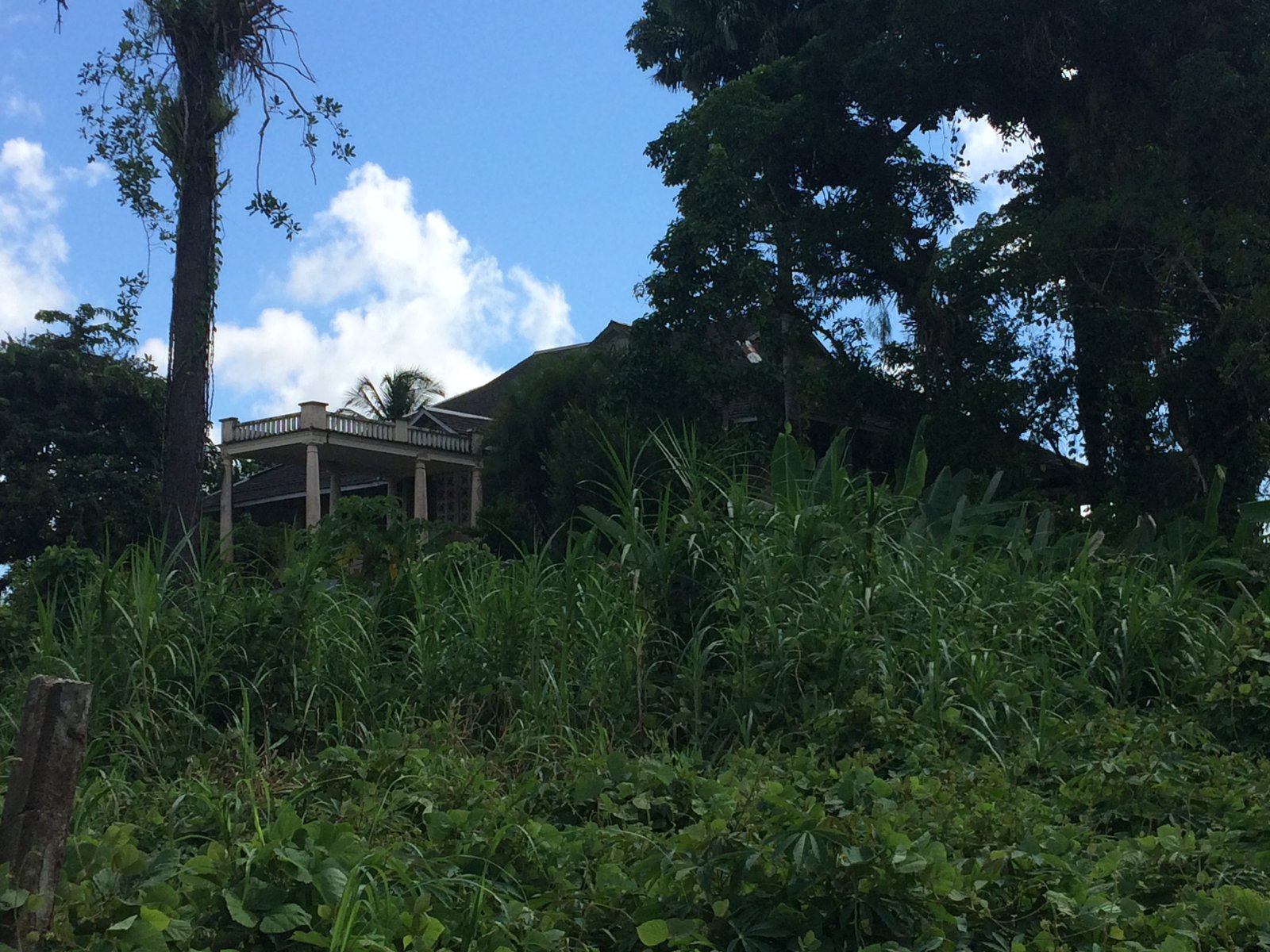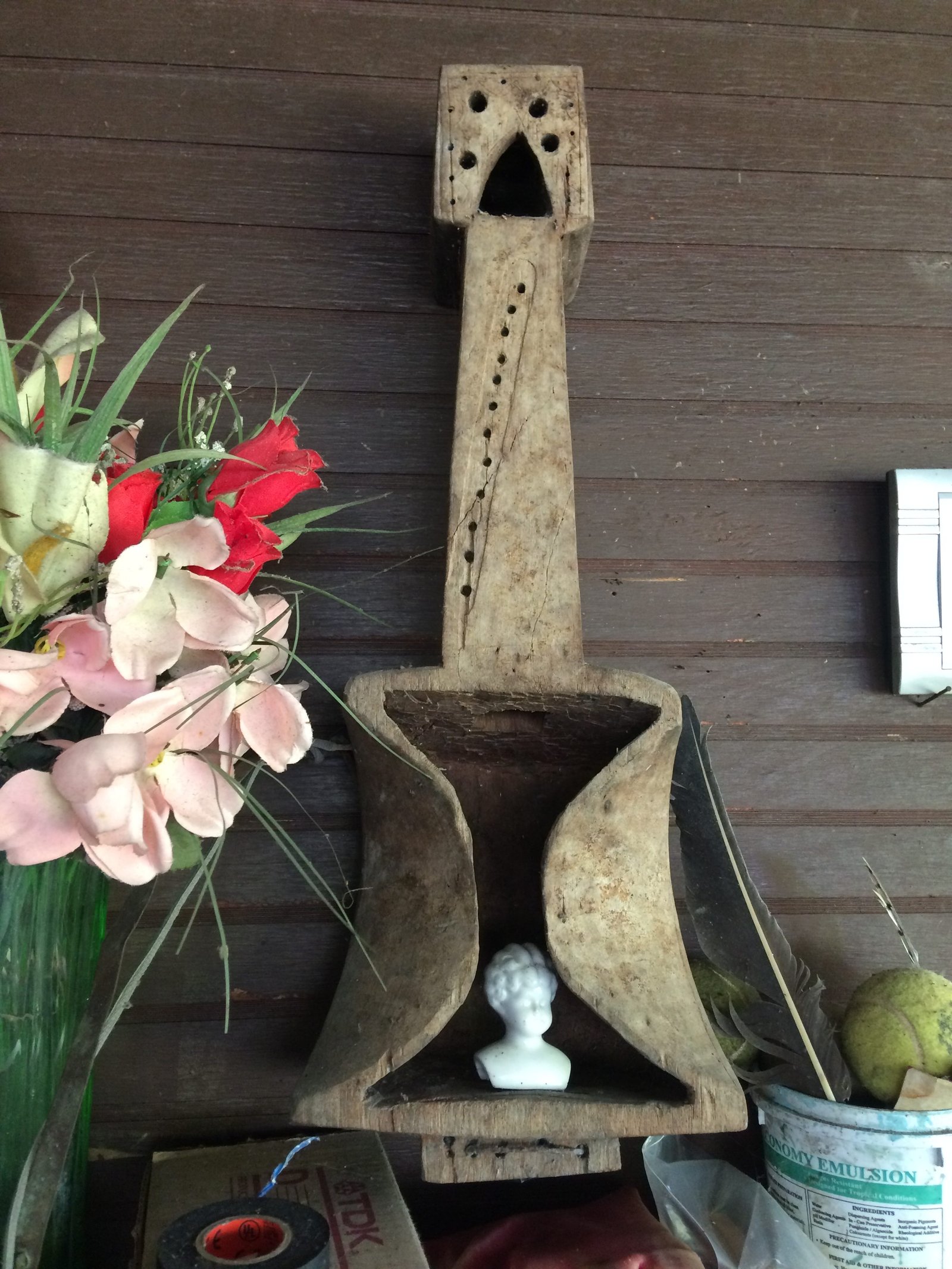Green Days by Ramdeen

“Trinidad is my land
And of it I am proud and glad…”
~Mighty Sniper (Portrait of Trinidad)
You ever met one of those cool grandfathers who told stories? Well, I had the privilege of meeting Leisha’s grandfather.
From the start, Mr. Ramdeen, a bright-eyed 82 year-old flanked by his protective canine, Oily that never left his side was a man with a myriad of life experiences. These are some of his memories he shared with us, giving us a taste into how life was “back in the early days”.
The Caiman Attack

“A couple of weeks ago I was 82. A lot of people are surprised that I attained this age. I went through quite a lot— motorcar accident, major surgery. I used to hunt and fish a lot and once experienced a serious attack by a caiman in the swamp.”
Caiman you say?! Do caimans attack people?
Mr. Ramdeen nonchalantly responded, “Not usually. Unless they have a nest, then they are very protective.”
About ten of us went fishing with a casting net in the Nariva Swamp. In the dry season, the water level goes very shallow; about 6-8 feet deep. We blocked two sections in the river: up and down. We blocked how much we could handle because the whole river is covered in vines and grass. So you first have to clean it out then cast your net. The net got stuck and I went down into the water to untangle it. The caiman could have bitten me anywhere on my body. But luckily, it held on to my leg and lifted me completely out of the water. I grabbed something on the bank and came out. That’s when I saw the condition of my leg. That was the end of fishing that day!
I had to walk from the swamp out to where the car was. I went to the hospital and got 35 stitches. I almost lost the leg too. At one point in time the doctors wanted to amputate the leg because the infection was spreading. It wasn’t getting better. Then the consultant, I’ll never forget his name, Dr. Awong, who was a member of Parliament, eventually saw the leg. I don’t know if he increased the strength of the antibiotics for about a week, but the infection showed signs of receding, and that is how the leg was saved. But it has remained smaller than the other one. They took out part of the bone. It’s a bit shorter (laughs). I walk on the flat okay. Coming up the stairs is easier but going down …
Mr. Ramdeen is a trooper. If you think that was all his encounters with wildlife, guess again.
The Belgium Stone
I got bitten by snakes a couple of times, and I got stung by scorpions about 3 times. I never got sick or went to the hospital. My grandfather had a Belgium stone. It was always in a bottle with some cotton and a razor blade. If you get stung by a scorpion or bitten by a snake, you just gash the area slightly and put the stone. The stone will cling on like a leech.
I got stung on my belly by a scorpion. I put the stone on it, sat down and watched TV. After about half an hour the stone fell out. I didn’t even feel sick.
The Agouti Massacre

When I met Mr. Ramdeen, right away I could tell he was a dog lover.
I always liked hunting from young. I had many hunting dogs, 15, all with their own names. There was one in particular, Barney, he died two years ago. One time he held an agouti and brought the whole thing here. Another time he brought half; he ate out half of it. It was a fresh kill, so I washed it, scraped out the hair, cut it up, cooked it and everybody ate. The half agouti in pure meat was 3 ½ pounds.
The Horn of Ruction
All the dogs I had, I would call and they would respond. I decided to use this horn my brother in London sent me. When you blow the horn, the dogs are supposed to stop immediately and come back. I had 6 hound dogs, and my daughter had about 8-9 pompeks which were loose all the time. I decided to train these young dogs with the horn. When I blew the horn there was endless dog fight. They got so excited, everybody was fighting. So I had to discard the horn.

Now only “Oily” and “Mop” remain. Oily was an abandoned puppy Mr. Ramdeen rescued, and bathed in used motor car oil for almost a month to cure his mange. He looks like he can star in a Pantene commercial with his healthy, shiny fur now.
Oily reminded me of my Dalmatian, Olly. She was the sweetest dog. When Aaron and I were dating, whenever he came home to visit, Olly would bark and growl at Aaron outside. But from the time they both stepped inside the house, she would roll over to get her tummy tickled by him. I guess she was keeping up appearances. Oily reminded me so much of her as he had the same reaction with Aaron for Mr. Ramdeen.
Pacheco estate

Every morning, when the horn blows, the workers would go out in different gangs and pick the cocoa, crack it, take out the seeds and make a big heap. They had these mules with these big baskets, called pannier, hanging on either side of the mules. The workers would pick up the cocoa, put it in these baskets and bring it back. Then put it in one of the several rooms in a big building to sweat (sweat box) and leave it there for a few days. When you put your hand in that cocoa, it feels extremely hot. After the cocoa sweat for a few days, they take it out. There was a trolley with rails that carried this cocoa to the endless cocoa houses on either side of the rails. They would empty it and open the cocoa house by pushing the roof off which was on wheels so that it will get the sun. The workers would turn the cocoa every now and then to let it dry. On a Sunday morning they used to dance the cocoa. The whole village used to be there “dancing the cocoa.” Then, they put it in bags, put it on the mule cart and carried it down to Sangre Grande.
There used to be a rubber factory on the estate too, around the 1940’s. There was a stand of rubber trees where the old children’s home used to be. The workmen used to go with a bucket or cup, and a knife to make diagonal cuts or “mark” the tree. They would put a nail in the tree with the cup beneath the “mark”. The milk from the rubber tree would seep into the cup overnight and the next day they would go and collect it. They would spread it out on some huge trays and leave it overnight so that the rubber part floats up while the water remains below. They would take out this sheet of rubber, cut it into sections and using a mill which had to be turned manually containing two rollers, put the sheet and squeeze out every bit of water. They then take it out and hang the sheets to dry, load them onto a truck and send them to some Dunlop place to make tyres. I don’t think there is anywhere else in Trinidad that produces the material to make rubber now.
Mr. Ramdeen’s father was the manager of this vast estate.
“Books and records were stored in the manager’s house, as well as 5 guns which were used to shoot squirrels that destroyed the cocoa. I inherited one of these guns from my father.”

I used to hear okay, but then developed hearing problems. I went to DRETCHI and did some kind of evaluation. You lose your sense of hearing, sometimes through accident or just because of age or things you do. I like shooting. Not practical to use earmuffs when you go to hunt.
The blast of the shotgun, for the years he has been hunting, gradually worsen the loss of hearing.
Most of the people in the whole village used to work on the estate. Christmas time was a treat for the workers.
My father would get them to bring moss and decorate the two chapels at Pacheco house like the Nativity scene—baby Jesus, his parents, shepherds, etc. They would make Pastelle, kill pigs and sheep. They would bar-be-que the sheep for the Indians who didn’t eat pork.
Childhood memories
“Bull get away!”

On Pacheco estate there were stables that housed cows, mules and hundreds of sheep. They would be loose and roamed the whole village. I could remember there was this bull with his little dewlaps. He had a separate stall with these thick bars to prevent him from coming out. I used to sit down on a bar and he used to come and put his head out. While he ate his bundle of grass, I would play with him. Whenever he got away, he used to roam the village. I could remember one time, my mother had just cooked in the kitchen and the food was on the marchan (table) against the wall made of tapia (dirt). The bull came and rubbed his horn on the dirt and the whole wall capsized!
Another time I was in the cocoa house, and someone shouted, “Bull get away!” I saw the bull running up the yard. So I went into the little tapia kitchen room and closed the door. He came and rubbed his horn on the wall and next, I saw the bull’s head inside the room. I had to scale the wall to run away!
When I was very young, I remember Pacheco’s son, grandson and granddaughter used to come up from Port of Spain to spend the weekend. They had some horses, and real nice Western style saddles and harnesses. Since my father was in charge of the estate and all the animals, I used to get to ride the horses too. I used to ride about and enjoy those times on that estate.
The Ferry
Mr. Ramdeen reminisced about the old car ferry that crossed the Mayaro River.
I remember using this ferry. There was a ramp that the ferry goes right up to, so you can drive your car up on it. There were two cables across the river and the boatman would pull the cables and the ferry would move across. Sometimes the people who were being transported had to lend a hand to keep the ferry straight because the falling tide and strong current would sometimes push the ferry to the side.
We used to go to “catch crab” at Cascadou Trace— that was over the river. When you arrived with the car by the ferry, the ferryman would bring the ferry across, you drive your car onto the ferry, go across, and go to catch your crab. If you wanted transport again, all you had to do was call the ferryman. There was a bell on either side of the river bank. You ring the bell and ferryman will come across again with the ferry. It was a slow process. In those days, people were not in a hurry like now. Everybody hustling to go somewhere.
The centre for Carnival celebrations in the olden times was in Grande. They had a fairly nice show. When my father used to take us to see Carnival, we would pack all the things to eat in two big bags. Then we’d go down and he’d park just outside Sangre Grande. My father would walk with a bench. We’d walk to the middle of Sangre Grande and put down the bench on the pavement (and the bags), and watch the bands parade on the street: Sailor bands, Midnight Robbers, Red Indians, Jab Jab.
Back then, boxing was popular. Whenever there was a boxing match; a heavy weight fight, a lot of people would come from the village to hear the match on the radio.
Family Tradition & Beliefs

Originally in every Hindu home, there is fasting for Divali. In most of the homes now they still do it. I do not follow the religion as such but my daughter is a strict Hindu. She is a vegetarian; she doesn’t eat any kind of meat or fish. However, I eat everything. For Divali, my daughter would have prayers where the pundit comes over. I respect her tradition so I will not eat meat in the house nor bring it inside the house. At that time, I observe all the traditions.
I believe religion is good; it helps to mould children to become better citizens. I think whatever your religion, you should not discard it. Try and follow the principles of whatever religion you believe in, be it Muslim, Hindu, or Christian because it doesn’t carry you on the wrong path.
But my belief in the hereafter is different from what other people believe. I had a book, years ago called “Superstition in all Ages”. It’s an account from a Roman Catholic priest named Jean Claude Meslier on his death bed. That book more or less supports my belief about the afterlife.
Folklore
Most of the children of this generation do not know about our original history; how things were in the past. I remember going up to Tobago in the mall. There was a section with a set of paintings. I was walking with my great granddaughter who was about 9 or 10 years old, and showing her the paintings. She couldn’t recognize anything. These are the same pictures that I grew up with about our local folklore. Children these days don’t know what it is about. It is not taught in schools.
If they brought back these things: our local history; the beginning when people came and what life was like, people will be more cognisant of the different cultures—different cultures make this a multicultural society. We don’t have any real local content in the teaching of Social studies; that is lacking in the schools. Things about our local folklore, you don’t hear about it in school: Douens, La Diablesse, Lagahoo, Soucouyant, etc. But they know about Werewolf and Dracula.
I could remember long time ago, when we used to be sitting down in the kitchen. My mother used to tell us local folklore stories. She had everybody wrapped in attention. Afterwards, everybody would be afraid to go in their rooms.
Folklore tales
The boy named “Douen”
In the village here, when I was a boy going to school, there was this boy they nicknamed “Douen”. Back then, the whole place was a whole lot of bush. The story was that he went somewhere in the bush and he was lost for a week. It was said that Douens lured him in and had him in the bush. He came back to school but he was kind of “half-crack” afterwards.
The many Soucouyant
Before a Soucouyant starts of as this ball of fire, she goes to this secret place, takes off her skin, changes into a ball of fire, then flies off to suck people. When she’s finished, she comes back to retrieve her skin which is usually stored in a mortar. If you find this place where the Soucouyant stores her skin, take salt and sprinkle it on the skin, she can’t go back into the skin. That’s the end of the Soucouyant.
The closest I ever came to seeing one of those characters was one night when I was hunting with a friend along this road. It’s a dead-end. While walking we saw this extremely bright light coming through the forest which had cocoa and immortelle trees. The light was coming through like an extremely bright bulb. It reached a tree then it stopped, illuminating the whole tree. Then it started moving again and disappeared. That was the closest thing that I experienced that could be attributed to something supernatural.
In Vega de Oropouche (Toco Road), people have been saying that they see some strange lights in the night. I went to see the lights and when we reached there, cars were parked up on both sides to see the light. But we didn’t see any lights. There are people who I know, like my cousins and the pundit from the temple who said they went and actually saw the lights. It appeared like two headlights from the car, and kept moving back and forth as they approached, then kept receding. But I didn’t see it. If it was a prank, then they will have had to do that every night for a long time.
We used to rear cows and had a cow pen in the back. There was something sucking the cows. They said it was a Soucouyant. One of my uncles waited for the whole night and said that a Soucouyant came like a bat on the cow. He started beating it with a whip, one like those Jab Jab used to use and the Soucouyant changed its form until it turned into a ball of fire and went.
There was an old lady living in the barracks. They said she used to turn into a Soucouyant. I could remember walking from school with an elder cousin who was with us. My cousin always used to steal chalk. This old woman, we used to call Hatrack was walking up the road.
My cousin said, “Bet you Hatrack pass in the bush. She not going over the cross.”
He took a chalk and drew a cross on the road. She stopped, quarrelled then passed around the cross.
Unsolved mysteries at Mr. Ramdeen’s house

Years ago, after my father had died, everybody was sitting in the living room looking at TV. It was getting dark when suddenly we heard “Click”. The light went out. Nobody was standing there by the switch; the light just went out by itself. Nobody could explain how it happened. It also happened once or twice again. One time, the light came on by itself.
More recently, my daughter came from work one day only to find that the towerbolt on her door (inside) was on. For that bolt to be on, somebody had to bolt it from the inside. But in order to get out of the room while the bolt was on, one would have to break the glass and come out the window. I walked around but no glass was broken. We used a luchette to open the door. How that bolt came to be on, nobody knows. Nobody was inside the room. The window was closed from inside. And that bolt was closed from inside. Up till now I cannot explain it.
Poorman’s Bridge
There was a trace called Lezama Trace but it’s built up now. There was this bridge called Poorman’s Bridge. When we had to go to the cinema, a set of young fellas from here, everybody at that time would ride bicycles. When we came back late in the night, nobody wanted to be the last to cross Poorman’s Bridge, because they said that it had a “spirit” there. If you were the last to reach, you would see a man sitting down without a head.
The Pacheco curse?
There used to be a rocker in the front gallery at Pacehco house. I never saw it happen but people said they used to hear the rocker rocking while nobody was there in the house. The house is kind of scary; it has an ominous vibe. It was built on the site of a cemetery. In front of the house, on the top of the hill was a little tomb with a big cross. One of the Pacheco brothers was buried there. On the estate, there was a room with stocks for feeding the animals like oil cakes, and they had a big iron keg filled with molasses. It was in that room one of Pacheco’s relatives committed suicide.
Mr Compere, a local shoemaker from the area would parade the village when he was drunk. He too committed suicide; he hanged himself by the mangrove. More recently, a young man who lived nearby, a pH taxi driver, hanged himself sometime the year before.
Film
When Aaron and I were driving to Sangre Chiquito, I was telling him about the book Green Days by the River that I studied for Literature in Secondary school. In the book, Joan was one of the girls from Sangre Grande whom Shell had liked. We were most pleasantly surprised to learn that a scene from the movie was filmed on the very gallery we sat and spoke with Mr. Ramdeen.
During filming for the local film Green Days by the River, Michael Mooleedhar, the director, came here with his team and asked for permission to use this building as part of the story.
“The original house in Mayaro that they wanted to use “gone through”, so this one was the closest to that house. They filmed the wedding scene right in this gallery. I didn’t know it takes so much to film a scene…how much they change clothes and come back…it felt like it took the whole day.”
On hearing this, I was curious to learn about what it took to make this film. Mr. Ramdeen has inspired and educated us on an era close to a century before our time. It was indeed a great pleasure to capture his memorable experiences!
In our next post, we look forward to exploring the journey of film director, Michael Mooleedhar. He has done an impressive job bringing to life on the big screen Trinidad and Tobago’s first-ever film adaptation of a local novel. The film, Green Days by the River, is based on the 1967 novel of the same name, by local author and historian Michael Anthony.
If you haven’t yet seen the film, or wish to see it again, you’re in luck!
It is available on Vimeo on Demand here.
What favourite stories did your grandparents share with you about life, “back in the early days”? We’d love to hear!